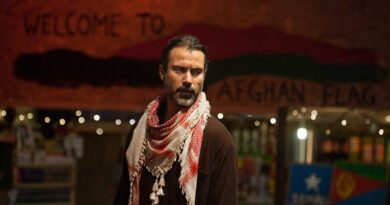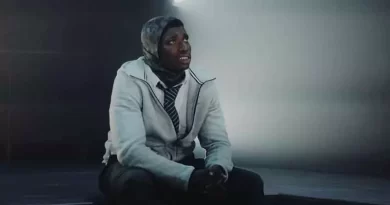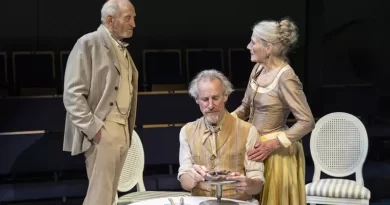“Ainadamar”, LA Opera
Annie Loui in Los Angeles
22 May 2025
Ainadamar is a spectacle of music, movement, and projection circling around the Spanish Civil War and its impact on art and social stability.

Photo credit: Cory Weaver.
Through stunning tableaux of political forces, the three protagonists – poet Garcia Lorca, the actress Margarita, and her student, Nuria, are positioned in song and vibrant staging against the political right. Franco’s Falangists are represented by projected 1930s newsprint, firing squads and uniformed men wielding staffs. The throbbing music and movement are heavily intoxicatingly influenced by flamenco and cante jondo, from the arm gestures and rhythmic stomping of the synchronized women’s chorus to the chillingly effective singing of Alfredo Tejada as the fascist vigilante rolled on a platform around the stage as he sings.
The spectacle, beautifully directed by Deborah Colker, with Flamenco choreography by Antonio Najarro, reveals one metaphoric layer of complexity after another as giant cylindrical curtains become a projection surface for over-sized hands and ivy-covered faces or a wall between the singer and the world or a giant column of blood.
The music, drawing on iconic Andalusian guitar and expressive arias, drives the massive chorus, Flamenco dancers, and principals (including the lovely mezzo soprano Daniela Mack singing Lorca as a trouser role). Osvaldo Golijov, the composer, won a Grammy in 2007 for the composition, as did the perceptive and subtle wordsmith David Henry Hwang for the libretto.
The ending of the production has the student, Nuria, running with much purpose over the stage as she sings, and Lorca’s poetry projected on the walls around her as the orchestra swells. She is joined by Lorca and Margarita, and the three protagonists dressed in white and red sing together resolutely. The message will live on; the historic struggle as people fight for self-realization while right-leaning interests seek to restrict will not be abandoned.

Daniela Mack (top) and Ana María Martínez.
Photo credit: Cory Weaver.
And yet, if there is a quibble with the production (truly operatic in its size of cast), the art forms involved, and the stunning co-ordination of light and motion and music, it is that I leave not quite sure what I am feeling. The story is told through symbols and icons, (sometimes on pedestals or in tableaux wheeled around the stage) but I somehow am missing the sense of the lyrics which seem dampened under all of the production values.
The protagonists are a vehicle for the larger political statement, and the personal sense of loss, disappointment or yearning only briefly emerges from the force of spectacle. This is a production worth seeing for the commitment of all of the performers. I have rarely seen performers sing so confidently as they walk down tables turned to slides, and the production warrants a visit for its kinetic energy and vibrant staging.
But I find myself wanting to ask David Henry Hwang if he captured what he wanted to convey. As a co-production between the Metropolitan Opera, NYC, Opera Ventures, Scottish opera, Detroit Opera, and the Welsh National Opera, it is clearly going to be produced around the world. Go and see it if opportunity arises, and answer the question I pose.









